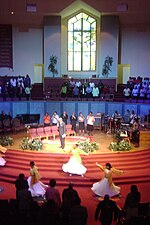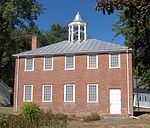Metropolitan Learning Center (Bloomfield, Connecticut)
Bloomfield, ConnecticutMagnet schools in ConnecticutPublic high schools in ConnecticutPublic middle schools in Connecticut
The Metropolitan Learning Center (MLC) is a magnet school that is based in Bloomfield, Connecticut. The school is part of the Capitol Region Education Council.
Excerpt from the Wikipedia article Metropolitan Learning Center (Bloomfield, Connecticut) (License: CC BY-SA 3.0, Authors).Metropolitan Learning Center (Bloomfield, Connecticut)
Blue Hills Avenue,
Geographical coordinates (GPS) Address Phone number Website External links Nearby Places Show on map
Geographical coordinates (GPS)
| Latitude | Longitude |
|---|---|
| N 41.8709 ° | E -72.7268 ° |
Address
Metropolitan Learning Center for Global and International Studies (Metropolitan Learning Center)
Blue Hills Avenue 1551
06002
Connecticut, United States
Open on Google Maps






